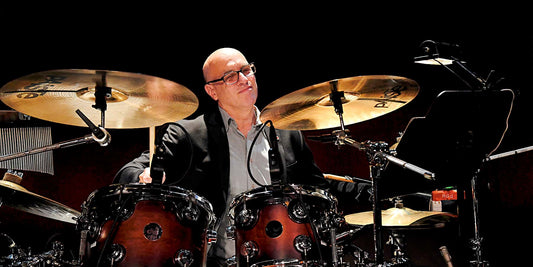
My Tuning Philosophy
By Sean McDaniel
Once I started playing Broadway shows I realized that I needed a consistent and reliable tuning system.
I wanted to be able to change heads without having anyone in the building notice that anything was different. I realized that the way to keep things scientific was to study which pitches allowed the top and bottom heads to sound their best.
When I was a kid I used to watch the DW videos about tuning to the shell frequencies. This inspired me to strip all the hardware off my Remo Mastertouch kit and find the pitches of each shell. While I didn’t always love where each drum sat when tuned to the shell note, it trained my ear to be able to fine-tune heads consistently. The other thing that helped my drum tuning ear was playing timpani in the youth orchestra. Once I got my first DW kit, the first thing I did was tune to the shell notes. I remember the 10” was a “B”. With both heads tuned to this note it gave a nice, resonant, all-purpose sound. I carried the notes of those shells in my head all those years, and always remembered that a B could make a 10” tom sound good. What I didn’t realize back then was how much a particular room could dictate tuning needs. When I started playing in different Broadway pits, I noticed that a perfectly tuned tom in my studio might sound completely wrong in a certain show. This led me to start keeping records of different pitch scenarios that worked in different situations.
I was tired of seeing instructional videos that said things like “a quarter turn of the drum key” or “tuning by feel”. Regardless of anyone’s tuning philosophy, there is always a pitch coming from each head!
I know many people are scared of tuning to “notes” and “pitches”, but having a drum in tune with itself does not mean it will clash with other instruments. The resulting pitch of the overall drum is a combination of both heads working together. A tom is unlike a timpani, which has one pure note. Watching those DW videos taught me about tuning each lug by tapping right at the edge of the shell, while the opposite head is muffled. I didn’t have YouTube back then to see millions of drum tuning videos!
As I moved on from tuning the top and bottom heads to the same pitch, I discovered that most of my favorite drummers tune their bottom heads higher. I wanted to find out how the relationship between the two heads affected the sound. I also wanted a scientific process that could be easily repeated. I was tired of seeing instructional videos that said things like “a quarter turn of the drum key” or “tuning by feel”. Regardless of anyone’s tuning philosophy, there is always a pitch coming from each head! So whenever I heard a drum that I liked, I would tap the top and bottom heads independently, then write down the notes. Later, I would tune my studio drums to the same pitches and record them to hear the results. I kept notebooks with all this data so that I could refer back when necessary. I also noted pitches from backline kits and from Broadway pits where I subbed.
A common denominator seemed to be having the bottom heads tuned a minor third higher than the top. So I developed a baseline set of tunings using these intervals. For a basic snare tuning I started using a D on the batter head with an F on the resonant head. For a 5-piece kit with three toms I would use Bb over Db for the 10” tom, F over Ab for the 12”, and A over C for the floor tom. The kick drum functions differently so I would usually try to get a 22” front kick head around an E or an F and then the batter head as low as it would go, sometimes even with wrinkles. You may be wondering which octaves these pitches are in, but there is usually only one octave that works, and it will be obvious. Those general tunings still work for me in mainstream groove music.
I’ve learned to experiment more when I get to a new drum booth, stage, or studio. The best part about having the system is that I can just move the heads up or down in half steps to see what works best for each drum. Also, some drums won’t be able to go as low as I want without getting flappy, and worn out heads won’t be able to tune as precisely. Sometimes in a rock club with backline, I will have to throw my system out the window, but on 99% percent of my gigs I will have the time to tune each drum with my system. I’ve found that nice studios and concert halls are much more forgiving. It’s the orchestra pits, drum booths, and other rooms with poor acoustics that need more experimentation. With this system I’ve been able to go into a recording studio, tune the drums without playing them, and not have to tweak them after recording has started. I might adjust the amount of muffling, but that’s it.
I urge every drummer to write down the pitches of the top and bottom heads every time you hear a good sounding drum. It can be on your own set or on someone else’s.
I’ve experimented with the bottom heads being a tritone higher on certain gigs if the drums are bigger. At my current Broadway show, I’ve even had the tom heads an octave apart! This may sound extreme, but the toms are big and I needed to reduce sustain. There are so many possibilities. One fun experiment is to start with both heads at the same pitch and write down what the fundamental pitch of the drum is when struck. Then move the heads up or down by half steps to see what it does to the fundamental. There are no wrong ways to tune!
I urge every drummer to write down the pitches of the top and bottom heads every time you hear a good sounding drum. It can be on your own set or on someone else’s. If you are playing a run of a musical somewhere and the drums are “dialed in” perfectly, then just write down the pitches. That way when you want to change heads down the road, you can recall the exact sound you had on opening night. My system has worked for me for years and I hope it will help some other drummers who are struggling with consistency. Below is a sample tuning chart:
Sample Tuning Chart:
These are just suggestions for starting places. Remember to tap each lug at the edge while muffling the opposite head.
Rock/Pop 5-Piece:
- 10” Bb/Db
- 12” F/Ab
- 14", 15", or 16” Bb/Db or A/C
- BD - Batter as low as possible, Front E or F
Rock/Pop 4-Piece:
- 12" or 13” E/G
- 16” A/C
- BD - Batter as low as possible, Front E or F
Jazz 4-Piece:
- 12” C# Top and Bottom
- 14” F# Top and Bottom
- BD - C or D Top and Bottom
Snare Drum:
- D/F# is a good medium tuning for most drums

Bio
Sean McDaniel is the drummer for the currently running Broadway production of Some Like It Hot.
On Broadway he has also originated the books for Disney's Frozen, Book of Mormon, Monty Python’s Spamalot, Dolly Parton’s 9 to 5, La Cage Aux Folles, and Violet.
Off-Broadway he originated the book for Hamilton. As a substitute on Broadway he has performed in 13 different shows.
Sean is also the drummer for American Idol Runner-Up Clay Aiken. With Clay, Sean has toured the country and played on many TV shows. He has also performed with Aaron Tveit, Audra McDonald, Jennifer Hudson, Sting, Dolly Parton, Stephanie Block, Idina Menzel, Cheyenne Jackson, Lin Manuel Miranda, Ruben Studdard, Ariana Grande, and Jane Lynch.
He maintains a busy freelance and recording schedule in New York City. Sean earned his BM at University of North Texas and his MFA at New York University.
Sean is a proud endorser of DW Drums, Evans Heads, Vic Firth Sticks and Mallets, and Sabian Cymbals.
He lives in New York City with his husband Ben Cohn, and son Allister.



